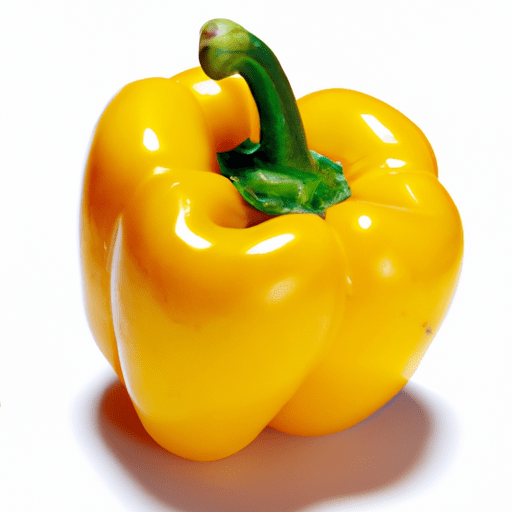Discover the Vibrant Yellow Bell Pepper: A Burst of Color and Flavour
When it comes to adding color, taste, and nutrition to your culinary creations, few ingredients can match the vibrant yellow bell pepper. This versatile vegetable, also known as the yellow capsicum, enlivens dishes with its sweet, slightly tangy flavor and eye-catching hue. In this post, we’ll delve into the world of yellow bell peppers, exploring their taste profile, common uses in cooking, nutritional value, and intriguing history.
Taste and Flavour
Yellow bell peppers are a delight for the taste buds. They offer a mild sweetness with just a hint of tanginess, setting them apart from their green counterparts. This mellow flavor profile makes them versatile in an array of dishes, complementing an assortment of other ingredients. Whether raw or cooked, their vibrant taste adds a refreshing component to salads, stir-fries, pasta dishes, and more.
Common Uses in Cooking
Raw:
Raw yellow bell peppers shine in salads, lending a crisp texture and vibrant color. Slice them into strips or chunks for a refreshing addition to your favorite greens. Their mild flavor pairs well with various salad dressings, making them a popular choice in Mediterranean-inspired dishes.
Roasted:
Roasting yellow bell peppers heightens their natural sweetness and imparts a smoky flavor. The charred skin, once peeled, offers a delightful contrast in texture. Roasted yellow bell peppers can be used as a standalone side dish, blended into creamy soups, or added to sandwiches, wraps, and pizzas for a burst of flavor.
Sauteed:
When sauteed, yellow bell peppers soften slightly while retaining their crunch. They work wonderfully in stir-fries, fajitas, and other similar dishes, where their vibrant color adds visual appeal. Combine sauteed yellow bell peppers with onions, garlic, and other vegetables for a satisfying medley of flavors.
Nutritional Value
Besides their taste and culinary versatility, yellow bell peppers offer an array of nutrients that contribute to a balanced diet. These vibrant vegetables are an excellent source of vitamin C, surpassing the vitamin C content found in many citrus fruits. Vitamin C is known for its immune-boosting properties and its role in collagen production.
Yellow bell peppers are also high in vitamin A, a nutrient crucial for eye health and immunity. Additionally, they contain dietary fiber, which aids digestion, and are low in calories, making them a great choice for those focusing on weight management.
Historical and Fun Facts
- Bell peppers, including the yellow variety, originated in Central and South America. They were brought to Europe by Christopher Columbus during his voyages in the late 15th century.
- The yellow bell pepper is actually a mature version of the green bell pepper. As it ripens, it changes color, develops a sweeter flavor and becomes easier to digest.
- In some cuisines, yellow bell peppers are considered a symbol of good luck and prosperity.
- Along with their culinary uses, yellow bell peppers are sometimes utilized in traditional medicine for their potential anti-inflammatory and antioxidant properties.
Now that you’re armed with knowledge about yellow bell peppers, it’s time to incorporate their delightful flavor and vibrant color into your cooking adventures. Whether you prefer them raw in salads, roasted as a side dish, or sauteed in a stir-fry, these versatile vegetables are bound to elevate your meals and leave your taste buds wanting more.
So, don’t hesitate to embrace the golden delights of yellow bell peppers and savor the joy they bring to your culinary creations!
Yellow Bell Pepper
Origin: The yellow bell pepper, also known as the yellow sweet pepper, is a variety of Capsicum annuum. It is believed to have originated in Central and South America, where it has been cultivated for thousands of years.
Common Uses: Yellow bell peppers are versatile and can be used in a variety of dishes. They add a mild, sweet flavor and vibrant color to salads, stir-fries, salsas, and sandwiches. They can also be roasted, grilled, stuffed, or used in soups and stews.
Nutritional Benefits: Yellow bell peppers are packed with essential nutrients. They are an excellent source of vitamin C, providing more than twice the daily recommended intake in just one medium-sized pepper. They also contain dietary fiber, vitamin A, vitamin B6, vitamin E, folate, and potassium. Additionally, they are low in calories and fat.
Unique Properties: Similar to other bell peppers, yellow bell peppers have a crisp, juicy texture and a mild flavor. The yellow variety is slightly sweeter compared to green or red bell peppers. Their color comes from the presence of carotenoids, which are also antioxidants that may provide health benefits. Yellow bell peppers can be easily identified by their bright yellow skin and bell-like shape.
Historical Significance: Although the exact timeline of yellow bell pepper cultivation is unclear, peppers were domesticated in Mexico around 5,000 to 6,000 years ago. They have played a significant role in Latin American, Caribbean, and Mediterranean cuisines for centuries. Peppers, including yellow bell peppers, were introduced to Europe by Christopher Columbus upon his return from the New World. Since then, they have become popular ingredients in many international food cultures.




Use the share button below if you liked it.
It makes me smile, when I see it.